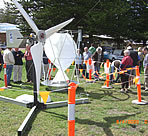Locally Owned Energy COOPS
Community Owned Energy Models – Two Examples
Hepburn Wind (est 2010)
Australia’s first Community Owned Energy Company is Hepburn Wind, located at Leonards Hill, 10 kilometres south of Daylesford in central Victoria. The facility comprises two REpower MM82 2.05 MW (megawatt) wind turbines, yielding a total capacity of 4 MW of power.
Noting how Denmark has fared with its community-owned wind farms, the Hepburn project grew out of a campaign by a few devotees to educate people about clean energy. The local community then raised funding of ($7.2m) to purchase the towers and so own the power produced. The turbines can power 2,300 homes.
This provides enough renewable electricity for almost all of the households in Daylesford and Hepburn Springs. The community also benefit every time they generate excess power as they sell it back into the grid at market prices.
Consultation and co-ownership of renewable energy set the community up for success.
Marin Energy (USA)
Marin Clean Energy (MCE) is based on a model known as Community Choice Aggregation, or CCA. As the name suggests, a CCA gives the community the power to choose where its energy comes from - and that can mean harnessing locally-available renewable energy sources. So a community can decide to install solar arrays or wind farms and feed any extra power back into the grid—rather than waiting for a utility company to do so.
Renewable Energy Types
Solar panels are becoming cheaper and more powerful. Bulk purchasing, or the model of renting out roof space to solar panel operators, sees prices falling at about 20% per year. Because renewable energy is sourced locally, money stays within the precinct providing the same economic stimulus as buy local programs.
The success of the above approaches lies in having energy delivered through small, distributed networks or smart grids - rather than from a single source or route, currently the model that dominates world power suppliers.
Locally owned renewable based energy companies offer revenue-generating mechanisms ensuring ratepayers do not pay more for renewable energy than fossil fuels. Energy COOPs even have the potential to drive energy prices down as they act through the market and can set their rates.
Traditional energy distributors rather than energy generators will be the first to recognise the potential of regional renewable energy COOPs.
Download the above Paper - Community Energy ![]() (PDF 58 KB)
(PDF 58 KB)





